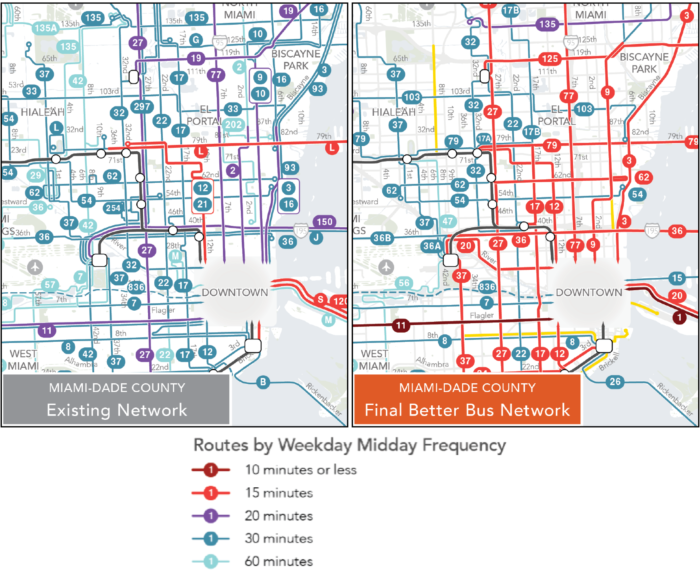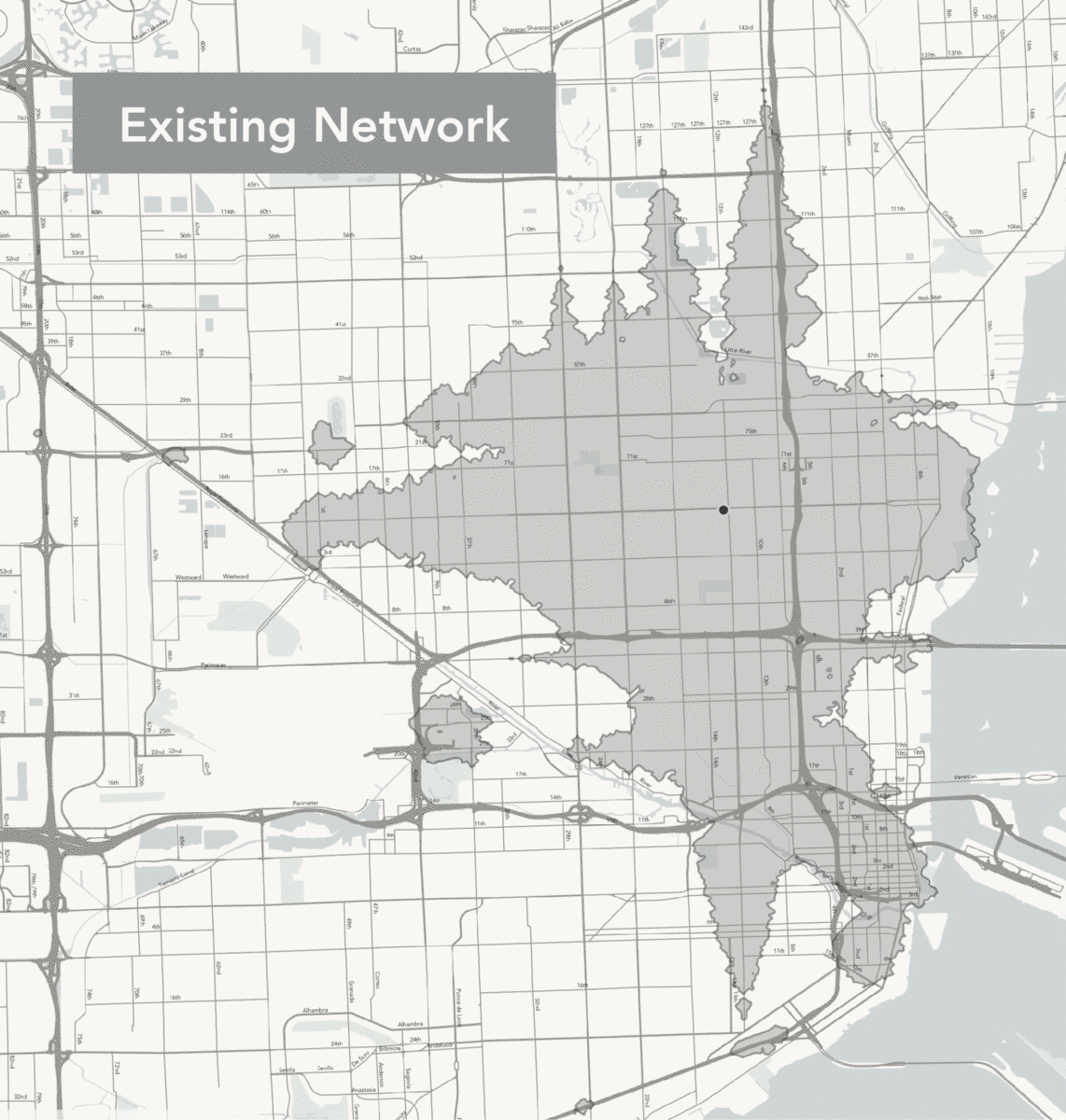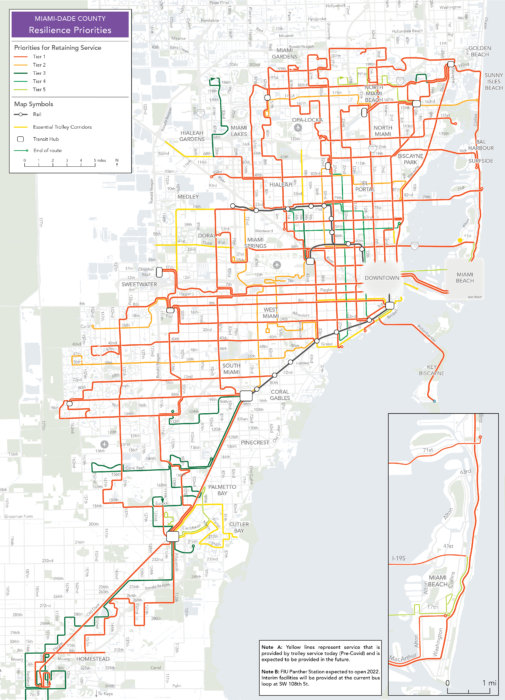For the past 18 months, we have been redesigning the bus network for Miami-Dade County, Florida with the local advocacy group Transit Alliance. As the final public engagement phase was coming to an end, the pandemic reached the United States, and like many other agencies, Miami-Dade Transit went into crisis management mode. So our work paused for about four months.
As the pandemic wore on, it became apparent that the agency needed more than a single transit network ready to implement. It needed a plan that could adapt to a range of unpredictable futures. Nobody knows how long the pandemic will go on, or what affect it will have on tax revenues that the agency relies on.
So, in finalizing the Better Bus Network, we worked with county staff and Transit Alliance to develop a Resilience Plan, to guide future decisions about how to ramp service up or down in the face of an unknown future.
But first, let’s talk about how we got here.
In the first phase of the project, we developed a Choices Report to analyze the existing network and discuss key questions that determine how the network should be designed. We took input from the public about those questions and developed two concept networks that highlight the tradeoffs between focusing on coverage and focusing on ridership. We returned to the public to ask them which way they lean between these the two concepts. Remember that it’s never one or the other; the ridership and coverage concepts represent two ends of a spectrum. Based on public input, we designed a Draft Network that was halfway between the two Concepts and now we revised it into the Final Network.
Below are slices of the Existing Network and New Network for the core of the region (click the maps to see the full-size maps of both networks).

A comparison of the maps of the Existing Network and the Final Better Bus Network in Miami-Dade County, Florida. Note the line colors, which indicate midday frequency.
Click here for the full map of the Existing Network
Click here for the full map of the Final Better Bus Network
The New Network creates a frequent grid that helps residents get to more places sooner. In this network, 353,000 more residents are near a frequent route (an increase of 13% over the existing network). With the new network, the average resident can reach 36% more jobs in 45 minutes by walking and transit.
The frequent grid means that it is easier for people to make connections between routes allowing them to get to many more places in a reasonable amount of time. The following animation shows where someone can get to in 45 minutes by walking and transit from Liberty City (NW 12th Avenue and 62nd Street). The gray area shows where someone can get to with the Existing Network and the light blue area shows where they can get to with the New Network. With the Better Bus Network, someone living in Liberty City can get to 60% more jobs and 50% more people. This is what we mean by access to opportunity.

This map shows the areas reachable from Liberty City within 45 minutes using the Existing Network and using the redesigned Final Network
This vast expansion in access is only possible because of the frequent grid. This means that if Miami-Dade Transit has less revenue but wants to maximize access like this, they have to protect the frequent grid. That is what the Resilience Plan does. The network’s corridors are divided into tiers to establish what service should be provided at different levels of revenue.
In the grimmest financial scenario (Tier 1), the network would keep only frequent corridors spaced every mile, and a few coverage routes that are critical to ensuring equitable access. Yes, this network will make people walk longer distances. But when they get to a route, a bus is always coming soon. If the County has more revenue, they can add the service in Tier 2 and so forth.
Nobody wants to see these service cuts, but if they become necessary, MDT will be able to minimize the damage to people’s access to opportunity by using the Resilience Plan. On the other hand, if MDT did service cuts the usual way – by leaving the routes as they are but cutting frequencies – access to opportunity would decrease drastically. Consolidating routes to make them more frequent can actually make people’s trips faster, despite the longer walks.
This Final Network is now in the hands of the County Commission to endorse and, if approved, to be implemented by Miami-Dade Transit. There will likely be additional opportunities to comment on this plan before it is implemented. If you’re in Miami-Dade County, remember to submit a comment or tell your Commissioner about this Plan, particularly if you like it. Sadly, most of the public comments received on transit plans are negative even if the plan is broadly popular, because people who like it falsely assume it will happen anyway. This plan will not be implemented if it does not attract strong support. The County would like constructive comments about the plan, which will be used to make the final implementation even better. But if you like the plan, it’s important to say that as well!

I like it. I really like the approach. I wish someone would do that for Seattle. Recent cut backs have caused them to do the opposite. The first thing to be cut was a major crosstown route — the only one for miles — which would have converted 50 minute trips to 20 minutes. All the while they are keeping express trips to downtown, even though the subway train will get them there (albeit with an extra transfer). The planners don’t seem to care about creating a grid (or even something close).
That was my thought too: I wish we had this kind of planning in Seattle. The University Link restructure in 2016 did do something similar: there were two initial alternatives, one an aggressive rail-feeder grid not focused on downtown, and another with minimum changes. Around 75% of the aggressive alternative made it to the final. But with covid there’s no multilevel plan saying what frequencies to expect under different contingencies. Most of the peak expresses are suspended to focus resources in the all-day network, so that’s good. We just had a round of frequency reductions due to low revenue and a 5-year levy expiring and its renewal uncertain, so the 15-minute gains are reverted to 30 minutes evenings and weekends, and the 10-minute gains are reduced to 15-20 minutes. But at least Metro seems to be responsive and to recognize the importance of the frequent corridors, so I have hopes they’ll return if the levy renewal passes and the economy recovers next year.
Sound Transit is, alas, not as responsive. Link light rail kept to an impressive 10 minutes until 10pm for its first ten years, but this year reduced to 20 minutes daytime, 30 minutes evenings and weekends. The purported reason for this was not insufficient revenue but higher security costs at stations when fares were suspended. Fares returned but the frequency didn’t. Finally in September frequency came back partway to 15 minutes daytime, 30 minutes evenings, and the medium-term plan keeps this frequency through at least March 2022, in spite of a major Link extension opening in September 2021. Some bus routes, especially the 255 to Kirkland and the northeast Seattle routes, were truncated at a non-downtown station predicated on Link being always frequent, but now Link is not frequent. Sound Transit has said it will increase frequency as crowding returns, as if crowding is the only reason for frequency. That contradicts “But when they get to a route, a bus is always coming soon” on the most core corridor, and contradicts Link’s own 10-minute commitment it kept for 10 years. Again, if the agency doesn’t have money it would have to cut, but it hasn’t said it has insufficient money, and some 75% of the revenue is going to capital projects (extensions) that could be delayed to keep frequency up. They are pausing some capital projects but they aren’t backfilling the frequency with it. This loses potential riders, who will take a 10-minute train but won’t take a 15-minute or especially 30-minute train, or who forego trips when they would have to transfer to an infrequent train.
I like the new plan. (I’ve been to Miami only once and didn’t ride any buses, only the metro and people mover.)
Comparing it to our situation in Alexandria, Va., where most service has been restored, I see some of the same principles. (I know you worked on a plan for Alexandria, but I don’t think any of it has been implemented yet.) The bus that goes past our apartment is hourly Monday through Saturday except half-hourly in weekday rush hours. We have to plan most trips around it, although it was abolished altogether for five months, which of course was worse.
On an errand earlier this month to Arlington, we had to ride three buses. I was pleased to see that one I used to commute on that had half-hourly service now runs every 20 minutes, and although some Arlington Transit bus lines have been suspended altogether (turning our two-bus trip into a three-bus trip), the trunk line we used runs every fifteen minutes off peak. This made it possible to plan only our departure time from home and expect (almost) frequent service on the other two lines. We planned our trip so we would come home in rush hour and have half-hourly service to our neighborhood. The alternative cuts mentioned in your post—possibly wider service but only hourly—are something I’ve experienced and they often make transfers terribly inconvenient or even useless unless it’s a pulse system. I’ve walked miles rather than wait most of an hour for a connection: walking is faster.
Although 15- and 20-minute service seems pretty good to us retirees compared to what we had, it still could make for long connections if I were still commuting to work.
So kudos for your Miami plan. Maybe I’ll get back there some day.
The statement that most people prefer the ridership network before the coverage network is a flawed statement. Naturally, most people live near the frequent routes, and these people will of course happily get a bus every 15 minutes instead of a bus every 20 minutes, even though the difference is not very large. On the other hand, some people have a bus once an hour in the coverage network, and no service at all in the ridership network. These people are fewer, but the difference for them is much larger. Hence, this is a typical “tyranny of the majority” situation. You should consider a different method in future redesigns, since you get the same result almost everywhere you ask people if they prefer the ridership network or the coverage network.
Johnny. Not true, because these aren’t statistically valid surveys for the most part. The universe of a survey isn’t the whole population but the people who respond to the survey, although we do some weighting on race and income if needed. People who respond to these surveys are always motivated by the strength of each person’s opinion and the extent of their interest, and when presenting the results I always emphasize that. While the answers usually lean toward ridership, there have been exceptions, and the degree of lean varies a lot.
I like the new plan. Last year I lived in Amsterdam for several months. You are one step further there.
Incidentally: a well-developed local transport system, a bicycle-friendly infrastructure and many citizens do without their cars.
More information here: https://www.travelguide.amsterdam/en/publictransport-gvb/tickets-fares/
they will certainly be of great help